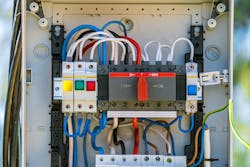Protecting Ungrounded Conductors
A fuse or the overcurrent trip unit of a circuit breaker must be connected in series with each ungrounded conductor [NEC Sec. 240.15(A)]. Also, the breaker must open all ungrounded conductors of the circuit both manually and automatically [240.15(B)]. There’s a pretty big twist to this, however, if you’re providing protection to motor circuits (see Parts III, IV, V, and XI of Art. 430).
For the ungrounded conductors of a:
1) Multiwire branch circuit that serves only single-phase line-to-neutral loads, you can use individual single-pole breakers with identified handle ties [240.15(B)(1)].
2) Line-to-line connected load on a single-phase circuit, you can use individual single-pole breakers rated 120/240V with identified handle ties [240.15(B)(2)].
3) 4-wire, 3-phase (or 5-wire, 2-phase) system, you can use individual single-pole breakers rated 120/240V with identified handle ties [240.15(B)(3]. Grounded neutral is required; voltage to ground can’t exceed 120V.
4) Line-to-line connected load on a 3-wire, DC circuit, you can use individual single-pole breakers rated 125/250V with identified handle ties [240.15(B)(4)]. Grounded neutral is required; voltage to ground can’t exceed 125V.
